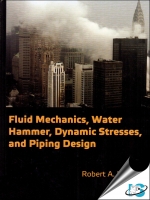Tab Article
For some, the use of the term "water hammer" evokes images of broken and bent piping, multi-million dollar damages, the loss of water supplies to cities, and the deaths of individuals due to water hammer accidents. Water hammer may be defined as an extreme fluid transient, occasionally recognized by loud banging, or hammering sounds, sometimes associated with fluid transients, which are caused by flow rate changes and resultant pressure surges, where the terms fluid transient and water hammer are frequently used interchangeably. The primary purpose of this text is to provide practicing engineers with the analytical tools required to identify water hammer concerns and prevent equipment damage, personnel injury, and fatalities. To do so, the principles of pipe system design with respect to fluid mechanics, valves, and pump operations are followed by basic structural piping design principles, water hammer theory, pipe system dynamics, and failure analysis. This text is intended for practicing engineers in the power and process piping areas who are concerned with the design, performance, and safety of piping equipment and components; specifically the identification, risk assessment, and prevention of water hammers in water, liquid, and steam piping systems. Relevant industries include power companies and utilities, pressure technology, valve and pipe manufacturers, and petro/chemical processing facilities. Overall, the text integrates multiple structural and fluids engineering disciplines to illustrate the principles of troubleshooting pipe systems for fluid flow problems and pipe failures.


